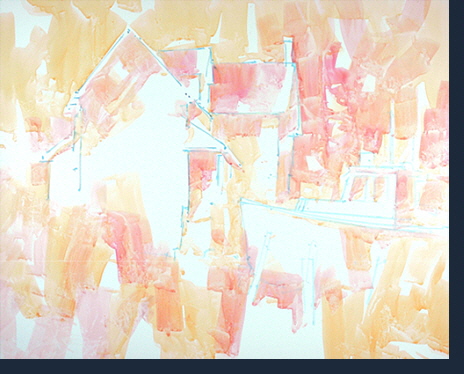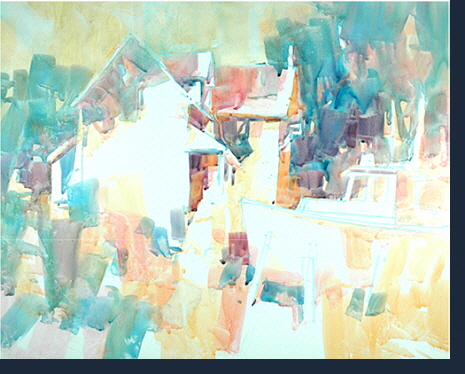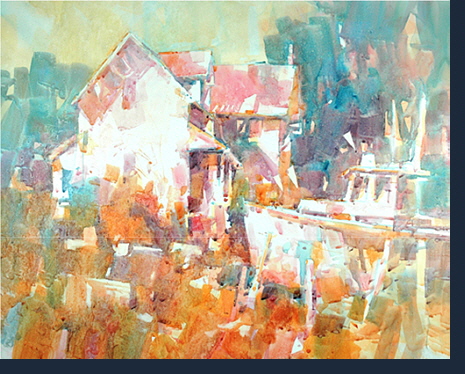YUPO AND THE CREATIVE PROCESS
Written for the Palette Magazine by Frederick C. Graff
As an artist and art educator for more than 50 years, I have found that my direction, palette, and materials have continued to change and evolve over the years. Despite the fact that my style and objectives still revolve around the concept of placing major emphasis on composition and retaining the transparent qualities of watercolor, my brush strokes have become more deliberate and expressive, my colors have become more intensified, and my entire painting process has become more suggestive and abstract.
Innovative painting surface
Over the years, I have thoroughly enjoyed painting on a variety of surfaces, but most recently I have been enthralled with Yupo. I have found that the lighter weight papers have a tendency to resist the paint, so the type of Yupo I use is the heavy weight 144 lb. paper. This innovative, synthetic paper has expanded my current direction and allows me to successfully pursue many of my traditional watercolor approaches. Often, artists experience problems because they work too wet. Instead of applying water to the surface with a brush, I find it to be more advantageous to lightly moisten the surface with a fine mist spray applicator that is not too forceful. This approach will easily provide more control and allow the newly applied paint to easily mix and integrate with any existing layers of paint. It is also beneficial to work on a slight angle rather than flat. Using very soft natural or synthetic-blend brushes is also recommended, as pure synthetic bristles will have a tendency to lift the paint and cause undesirable effects.
Brainstorming
Instead of using photo references, I enjoy working from preliminary studies that have been completed on location using either Faber-Castell Grey Big Brush Pens or directly painted with a very simple monochromatic color scheme. If necessary, I will create additional studies of the original preliminary drawing before making my final decision. The idea for this watercolor evolved by combining two separate preliminary studies that were done on location in Stonington, Maine.
Getting Started
Using a #6 to #8 round brush, I block in only the basic shapes of the overall composition with a relatively neutral color. This approach allows me to easily make necessary adjustments and corrections by erasing any brush marks with a damp, non-lotion Kleenex tissue without permanently damaging the painting surface. Neutral colored pencils can also be used as a blocking in medium. Generally speaking, you paint in the same manner in which you develop your layout. In other words, a tight and detailed rendering will usually influence the artist to paint in a similar manner, and therefore an abstract or incomplete layout promotes a less detailed painting. With that in mind, I intentionally try to be as spontaneous and suggestive as possible when I block in my basic shapes.
Applying Underglazes
Using the spray applicator, I lightly pre-moisten the painting surface before applying a series of light washes of color with the largest wash brush possible. I intentionally avoid using synthetic brushes as they have a tendency of lifting off the paint. Therefore, I highly suggest natual or synthetic blend wash brushes. Underglazes help reinforce the concept of developing the painting as a whole and harmonize the overall color balance. These light washes of color can be pursued all at one time or in separate individual steps. However, in the latter case, it is necessary to always lightly respray the surface before applying additional color. These underglazes help suggest the light source and define some of the structures. As each color is applied, I randomly leave a number of void areas to create interesting abstract shapes that will affect the next application of color. The sequence and choice of colors I use for my underglazes will vary accordingly. However, since I am working in a transparent manner, I intentionally try to avoid greens and violets for my underglazes, as they will evolve naturally. It is very important to think abstractly and not to be so easily influenced by the predrawn lines. As the painting develops, my ultimate objective is to capitalize on the opportunity to retain as many underglazes as possible. For example, the porch columns were created by negatively painting around them, but, at the same time, I retained a few existing underglazes within the negative spaces that surround them.
Retaining Natural Whites
Despite the fact that paint can be easily lifted off the Yupo surface, I always strive to leave as many natural whites as possible. Since I work with staining colors, pure whites cannot always be achieved when lifting color. With this particular painting, I retained and retrieved new whites as the painting evolved. Lifted areas were usually further developed by negatively painting around the newly found shapes in order to soften some of their hard edges.
Composition and Design
Throughout the entire painting process, I continued to resolve compositional problems. In the final step, I added a chimney to the front gabled roof and extended the height of the trees on the left side in order to eliminate a visual tangent that caused the eye to travel straight across the treetops and continue along the building rooflines. A last minute adjustment wa s to add a figure to create a stronger center of interest and to establish a stronger rhythmic pattern of whites that link the boat and house together. Another technique that I often try to implement is to decrease the values, intensity and detail as the eye moves further away from the center of interest. It is extremely important to go beyond just recording facts, to be open-minded, and to always be willing to change direction at any given time.
Thinking and Painting
While everyone’s style and approach to watercolor painting is uniquely different, the one goal that we all should have in common is composition and design. Every brush stroke is a means of expression, and, instead of just going through the motions of coloring in shapes without thought, one needs to be cognizant of design as the painting develops. Although it takes time and patience for any new concept or approach to evolve and develop in a natural manner, the information in this article should enable you to further expand your personal style and direction of painting in watercolor.




